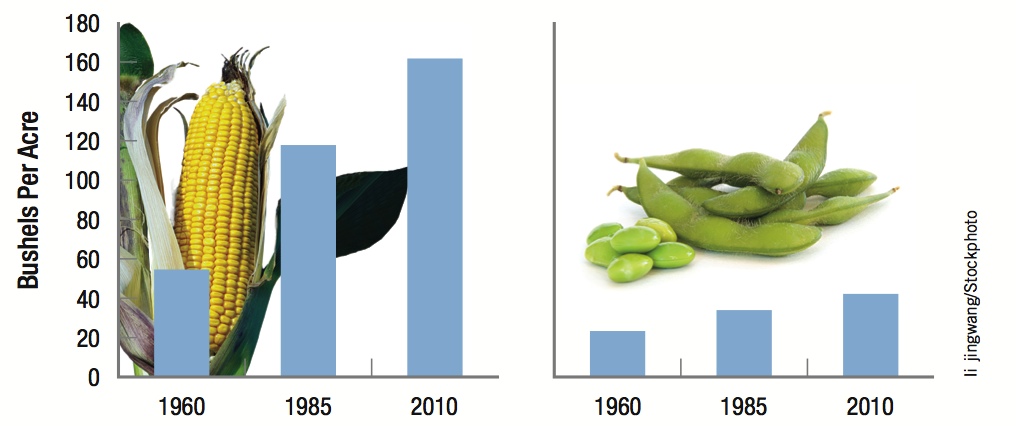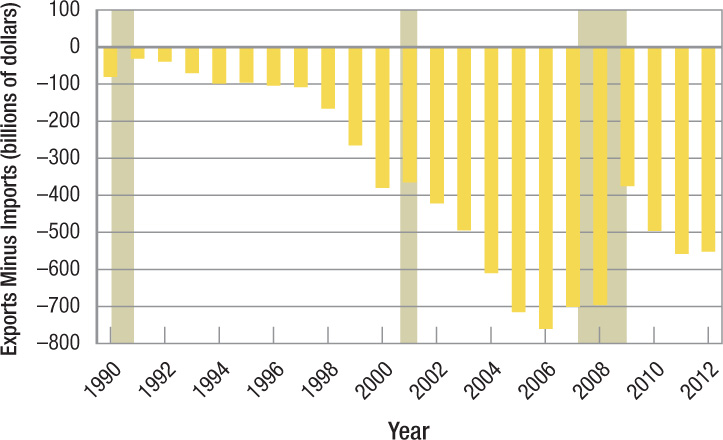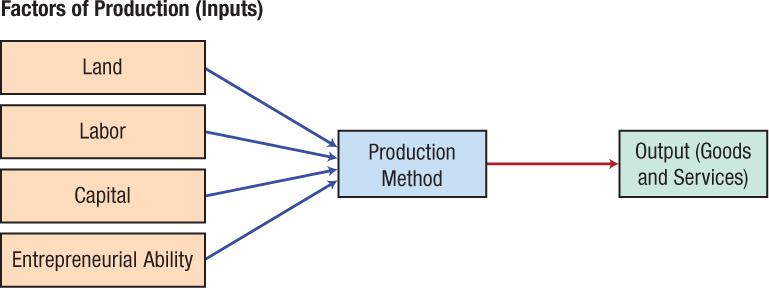Basic Economic Questions and Production
Regardless of the country, its circumstances, or its precise economic structure, every economy must answer three basic questions.
Basic Economic Questions
The three basic economic questions that each society must answer are:
- What goods and services are to be produced?
- How are these goods and services to be produced?
- Who will receive these goods and services?
The response an economy makes to the first question—What goods and services should it produce?—depends on the goods and services a society wants. In a communist state, the government decides what a society wants, but in a capitalist economy, consumers signal what products they want by way of their demands for specific commodities. In the next chapter, we investigate how consumer demand for individual products is determined and how markets meet these demands. For now, we assume that consumers, individually and as a society, are able to decide on the mix of goods and services they most want, and that producers supply these items at acceptable prices.
Growth, Productivity, and Trade Are Key to Our Prosperity
Over the last century, investment in education, infrastructure, and technology development, along with increased international trade, has resulted in increased productivity and growth, leading to higher incomes and standards of living around the world.

Farm productivity has dramatically increased since 1960 as a result of modern agricultural machinery and new seeds and fertilizers, resulting in higher yields per acre of crops such as corn and soybeans.


Firing workers can be costly in some countries. Firing a full-time worker with 20 years at the company costs roughly 70 weeks pay in Germany, but it is even more costly in China.

Our trade balance (exports minus imports) has grown steadily negative over the last two decades. During each of the last three recessions (shaded areas), our purchases of imports fell, improving our trade balance.

American attitudes about concerns for the environment or a preference for economic growth vary based on the state of the economy. As the economy enters a recession (shaded areas), the desire for economic growth increases while concern for the environment ebbs.
Once we know what goods a society wants, the next question its economic system must answer is, How are these goods and services to be produced? In the end, this problem comes down to the simple question of how land, labor, and capital should be combined to produce the desired products. If a society demands a huge amount of corn, for example, we can expect its use of land, labor, and capital will be different from a society that demands digital equipment. But even an economy devoted to corn production could be organized in different ways, perhaps relying on extensive use of human labor, or perhaps relying on automated capital equipment.
Once an economy has determined what goods and services to produce and how to produce them, it is faced with the distribution question: Who will get the resulting products? Distribution refers to the way an economy allocates to consumers the goods and services it produces. How this is done depends on how the economy is organized.
Economic Systems All economies have to answer the three basic economic questions. How that is done depends on who owns the factors of production (land, labor, capital, and entrepreneurship) and how decisions are made to coordinate production and distribution.
In capitalist or market economies, private individuals and firms own most of the resources. The what, how, and who decisions are determined by individual desires for products and profit-making decisions by firms. Product prices are the principal mechanism for communicating information in the system. Based on prices, consumers decide whether to buy or not, and firms decide how to employ their resources and what production technology to use. This competition between many buyers and sellers leads to highly efficient production of goods and services. Producers are free to survive or perish based on their efficiency and the quality of their products. The government’s primary roles are protecting property rights, enforcing contracts between private parties, providing public goods such as national defense, and establishing and ensuring the appropriate operating environment for competitive markets. Today the U.S. economy is not a pure laissez-faire (“leave it alone,” or minimal government role) market economy but more of a mixed economy with many regulations and an extended role for government.
In contrast, planned economies (socialist and communist) are systems in which most of the productive resources are owned by the state and most economic decisions are made by central governments. Big sweeping decisions for the economy, often called “five-year plans,” are centrally made and focus productive resources on these priorities. Both the former Soviet Union and China (until quite recently) were highly centrally planned, and virtually all resources were government owned. Although Russia and China have moved toward market economies, a large portion of each country’s resources is still owned by the state. Socialist countries (e.g., the Scandinavian nations of Europe) enjoy a high degree of freedom with a big role both for government services paid for by high taxes, and for highly regulated private businesses.
Resources and Production
production The process of converting resources (factors of production)—land, labor, capital, and entrepreneurial ability—into goods and services.
resources Productive resources include land (land and natural resources), labor (mental and physical talents of people), capital (manufactured products used to produce other products), and entrepreneurial ability (the combining of the other factors to produce products and assume the risk of the business).
land Includes natural resources such as mineral deposits, oil, natural gas, water, and land in the usual sense of the word. The payment to land as a resource is called rent.
labor Includes the mental and physical talents of individuals who produce products and services. The payment to labor is called wages.
capital Includes manufactured products such as tractors, welding equipment, and computers that are used to produce other goods and services. The payment to capital is referred to as interest.
entrepreneurs Entrepreneurs combine land, labor, and capital to produce goods and services. They absorb the risk of being in business, including the risk of bankruptcy and other liabilities associated with doing business. Entrepreneurs receive profits for this effort.
Having examined the three basic economic questions, let’s take a look at the production process. Production involves turning resources into products and services that people want. Let’s begin our discussion of this process by examining the scarce resources used to produce goods and services.
Land For economists, the term land includes both land in the usual sense as well as all other natural resources that are used in production. Natural resources such as mineral deposits, oil and natural gas, and water are all included by economists in the definition of land. Economists refer to the payment to land as rent.
Labor Labor as a factor of production includes both the mental and physical talents of people. Few goods and services can be produced without labor resources. Improvement to labor capabilities from training, education, and apprenticeship programs—typically called human capital—all add to labor’s productivity and ultimately to a higher standard of living. Labor is paid wages.
Capital Capital includes all manufactured products that are used to produce other goods and services. This includes equipment such as drill presses, blast furnaces for making steel, and other tools used in the production process. It also includes trucks and automobiles used by businesses, as well as office equipment such as copiers, computers, and telephones. Any manufactured product that is used to produce other products is included in the category of capital. Capital earns interest.
Note that the term capital as used by economists refers to real (or physical) capital—actual manufactured products used in the production process—not money or financial capital. Money and financial capital are important in that they are used to purchase the real capital that is used to produce products.
Entrepreneurial Ability Entrepreneurs combine land, labor, and capital to produce goods and services, and they assume the risks associated with running a business. Entrepreneurs combine and manage the inputs of production, and manage the day-to-day marketing, finance, and production decisions. Today, the risks of running a business are huge, as the many bankruptcies and failures testify. Globalization has opened many opportunities as well as risks. For undertaking these activities and assuming the risks associated with business, entrepreneurs earn profits.
Production and Efficiency
Production turns resources—land, labor, capital, and entrepreneurial ability—into products and services. The necessary production factors vary for different products. To produce corn, for instance, one needs arable land, seed, fertilizer, water, farm equipment, and the workers to operate that equipment. Farmers looking to produce corn would need to devote hundreds of acres of open land to this crop, plow the land, plant and nurture the corn, and finally harvest the crop. Producing digital equipment, in contrast, requires less land but more capital and more highly skilled labor.
As we have seen, every country has to decide what to produce, how to produce it, and decide who receives the output. Countries desire to do the first two as efficiently as possible by choosing the production method that results in the greatest output using the least amount of resources. Figure 1 shows how factors of production enter into a production method to generate goods and services. Determining the production method is the role of a manager, who must decide how factors of production are best used. Economists refer to this actual choice as the production function, a concept that will be discussed in greater detail in a later chapter. For now, just understand that how resources are used is as important as the amount of resources available.
FIGURE 1
From Factors of Production to Output Each of the four factors of production is employed in a production method in order to generate goods and services. The ability to use factors of production efficiently within a production method increases the amount of output given an amount of inputs used.
production efficiency Goods and services are produced at their lowest resource (opportunity) cost.
Productivity is a measure of efficiency determined by the amount of output produced given the amount of inputs used. But economists also use specific concepts to describe two different aspects of efficiency: production efficiency and allocative efficiency.
Production efficiency occurs when the mix of goods is produced at the lowest possible resource or opportunity cost. Alternatively, production efficiency occurs when as much output as possible is produced with a given amount of resources. Firms use the best technology available and combine the other resources to create products at the lowest cost to society.
allocative efficiency The mix of goods and services produced is just what the society desires.
Allocative efficiency occurs when the mix of goods and services produced is the most desired by society. In capitalist countries, this is determined by consumers and businesses and their interaction through markets. The next chapter explores this interaction in some detail. Needless to say, it would be inefficient (a waste of resources) to be producing cassette tapes in the age of digital music players. Allocative efficiency requires that the right mix of goods be produced at the lowest cost.
Every economy faces constraints or limitations. Land, labor, capital, and entrepreneurship are all limited. No country has an infinite supply of available workers or the space and machinery that would be needed to put them all to work efficiently. No country can break free of these natural restraints. Such limits are known as production possibilities frontiers, and they are the focus of the next section.
BASIC ECONOMIC QUESTIONS AND PRODUCTION
- Every economy must decide what to produce, how to produce it, and who will get what is produced.
- Production is the process of converting factors of production (resources)—land, labor, capital, and entrepreneurial ability—into goods and services.
- To the economist, land includes both land and natural resources. Labor includes the mental and physical resources of humans. Capital includes all manufactured products used to produce other goods and services. Entrepreneurs combine resources to manufacture products, and they assume the risk of doing business.
- Production efficiency requires that products be produced at the lowest cost. Allocative efficiency occurs when the mix of goods and services produced is just what society wants.
QUESTION: The one element that really seems to differentiate entrepreneurship from the other resources is the fact that entrepreneurs shoulder the risk of the failure of the enterprise. Is this important? Explain.
Typically, entrepreneurs put not only their time and effort into a business but also their money, often pledging private assets as collateral for loans. Should the business fail, they stand to lose more than their jobs, rent from the land, or interest on capital loaned to the firm. Workers can get other jobs, landowners can rent to others, and capital can be used in other enterprises. The entrepreneur must suffer the loss of personal assets and move on.